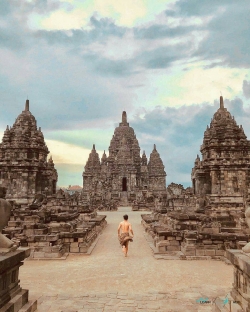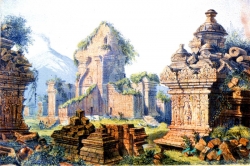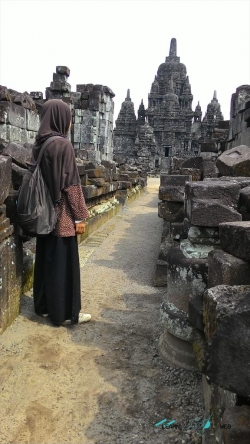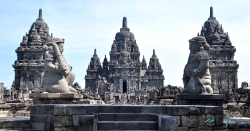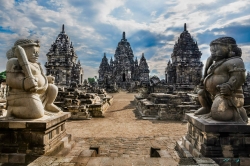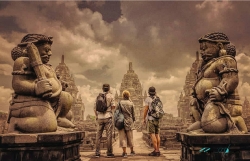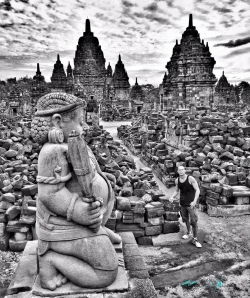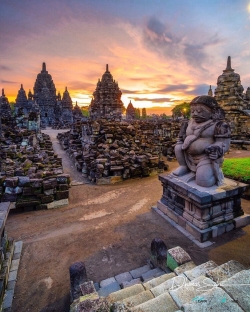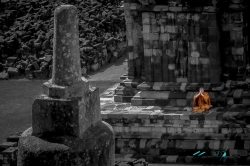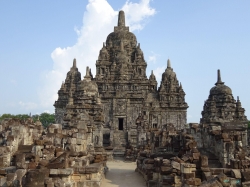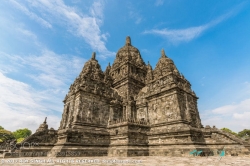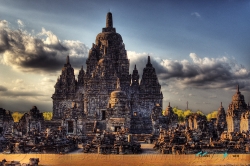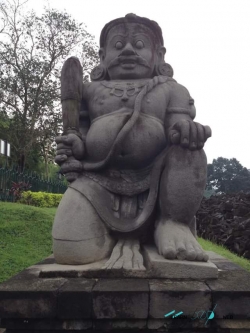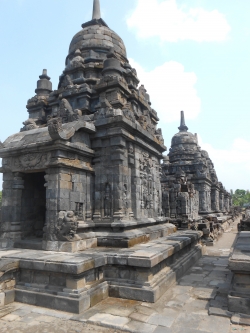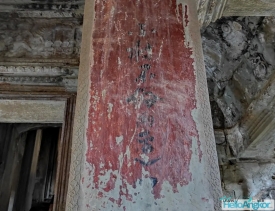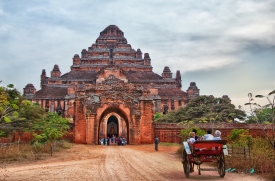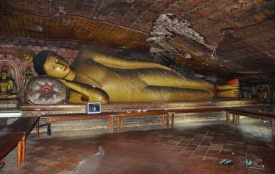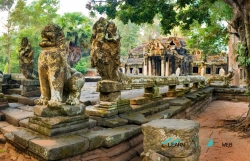ABOUT Sewu
Sewu is an eighth century Mahayana Buddhist temple located 800 metres north of Prambanan in Central Java, Indonesia. The word for a Hindu or Buddhist temple in Indonesian is "candi," hence the common name is "Candi Sewu." Candi Sewu is the second largest Buddhist temple complex in Indonesia; Borobudur is the largest. Sewu predates nearby "Loro Jonggrang" temple at Prambanan. Although the complex consists of 249 temples, this Javanese name translates to 'a thousand temples,' which originated from popular local folklore (The Legend of Loro Jonggrang). Archaeologists believe the original name for the temple compound to be Manjusrigrha.
According to the Kelurak inscription (dated from 782 CE) and the Manjusrigrha inscription (dated from 792 CE), which were discovered in 1960, the original name of the temple complex was probably "Manjusri grha" (The House of Manjusri). Manjusri is a Bodhisattva from Mahayana Buddhist teachings that symbolizes the "gentle glory" of transcendent wisdom (Sanskrit: prajñā). Sewu Temple was built by the end of eighth century at the end of Rakai Panangkaran's reign and was completed during the reign of his successor, King Indra. Rakai Panangkaran (746–780 CE) was well known as a devoted Mahayana Buddhist king who ruled the Medang Mataram Kingdom.
The Manjusrigrha temple was the largest Buddhist temple in the Prambanan Plain region, predating the nearby Prambanan Shivaist temple by over 70 years and the Borobudur by about 37 years. Located in the heart of Mataram, the temple served as the royal Buddhist temple of the kingdom. Stately religious ceremonies were held here regularly. The Manjusrigrha inscription (792) praises the perfect beauty of the prasada (tower) of this temple compound. The Bubrah temple, located several hundred meters south, and the Gana temple, located east of the Sewu temple, probably served as guardian temples for the Manjusrigrha complex, guarding the four cardinal directions around the Sewu temple. The ruins of the Lor temple to the north of Sewu and the Kulon temple on the western side are both in poor condition; only a few stones remain on those sites. Prior to the construction of Borobudur and Prambanan, Sewu likely served as the kingdom's main temple. The temples are arranged in the mandala layout, which symbolizes the universe in Buddhist cosmology.
Sewu temple was probably expanded and completed during the rule of Rakai Pikatan, a prince who married a Buddhist princess from the Sailendra dynasty, Pramodhawardhani. Most of his subjects retained their old religions after the court returned to favour Hinduism. The proximity of the Sewu temple to Prambanan, a Hindu Temple, suggests that the Hindu and Buddhist communities lived in harmony during the era in which the temples were built. And the scale of the temple complex suggests that Candi Sewu was a royal Buddhist temple that served as an important religious site. The temple is located on the Prambanan Plain, between the southeastern slopes of the Merapi volcano and the Sewu mountain range in the south, near the present border of Yogyakarta province and Klaten Regency in central Java. The plain has many archaeological sites scattered only a few miles apart, which suggests that this area served as an important religious, political, and urban center.
According to the Kelurak inscription (dated from 782 CE) and the Manjusrigrha inscription (dated from 792 CE), which were discovered in 1960, the original name of the temple complex was probably "Manjusri grha" (The House of Manjusri). Manjusri is a Bodhisattva from Mahayana Buddhist teachings that symbolizes the "gentle glory" of transcendent wisdom (Sanskrit: prajñā). Sewu Temple was built by the end of eighth century at the end of Rakai Panangkaran's reign and was completed during the reign of his successor, King Indra. Rakai Panangkaran (746–780 CE) was well known as a devoted Mahayana Buddhist king who ruled the Medang Mataram Kingdom.
The Manjusrigrha temple was the largest Buddhist temple in the Prambanan Plain region, predating the nearby Prambanan Shivaist temple by over 70 years and the Borobudur by about 37 years. Located in the heart of Mataram, the temple served as the royal Buddhist temple of the kingdom. Stately religious ceremonies were held here regularly. The Manjusrigrha inscription (792) praises the perfect beauty of the prasada (tower) of this temple compound. The Bubrah temple, located several hundred meters south, and the Gana temple, located east of the Sewu temple, probably served as guardian temples for the Manjusrigrha complex, guarding the four cardinal directions around the Sewu temple. The ruins of the Lor temple to the north of Sewu and the Kulon temple on the western side are both in poor condition; only a few stones remain on those sites. Prior to the construction of Borobudur and Prambanan, Sewu likely served as the kingdom's main temple. The temples are arranged in the mandala layout, which symbolizes the universe in Buddhist cosmology.
Sewu temple was probably expanded and completed during the rule of Rakai Pikatan, a prince who married a Buddhist princess from the Sailendra dynasty, Pramodhawardhani. Most of his subjects retained their old religions after the court returned to favour Hinduism. The proximity of the Sewu temple to Prambanan, a Hindu Temple, suggests that the Hindu and Buddhist communities lived in harmony during the era in which the temples were built. And the scale of the temple complex suggests that Candi Sewu was a royal Buddhist temple that served as an important religious site. The temple is located on the Prambanan Plain, between the southeastern slopes of the Merapi volcano and the Sewu mountain range in the south, near the present border of Yogyakarta province and Klaten Regency in central Java. The plain has many archaeological sites scattered only a few miles apart, which suggests that this area served as an important religious, political, and urban center.



